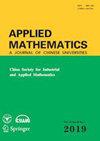基于加权支持向量机的信用卡欺诈检测
IF 1
4区 数学
Applied Mathematics-A Journal of Chinese Universities Series B
Pub Date : 2020-12-08
DOI:10.4236/am.2020.1112087
引用次数: 10
摘要
信用卡欺诈数据高度不平衡,呈现出绝大部分非欺诈交易和一小部分欺诈交易。用于判断检测算法准确性的度量对于部署一个模型至关重要,该模型可以准确地对欺诈性交易进行评分,同时考虑到案例的不平衡,以及在实际上是欺诈性交易时将案例识别为真实案例的成本。本文提出了一种考虑误分类代价的分类算法评判准则,并用该准则对几种欠采样技术进行了比较。同时,提出了一种考虑误分类财务代价的加权支持向量机(SVM)算法,证明该算法比传统方法更适用于信用卡欺诈检测。该加权支持向量机使用交易余额作为欺诈性交易的权重,并使用统一的权重作为非欺诈性交易的权重。结果表明,该策略大大提高了信用卡欺诈检测的性能。本文章由计算机程序翻译,如有差异,请以英文原文为准。
Credit Card Fraud Detection Using Weighted Support Vector Machine
Credit card fraudulent data is highly imbalanced, and it has presented an overwhelmingly large portion of nonfraudulent transactions and a small portion of fraudulent transactions. The measures used to judge the veracity of the detection algorithms become critical to the deployment of a model that accurately scores fraudulent transactions taking into account case imbalance, and the cost of identifying a case as genuine when, in fact, the case is a fraudulent transaction. In this paper, a new criterion to judge classification algorithms, which considers the cost of misclassification, is proposed, and several undersampling techniques are compared by this new criterion. At the same time, a weighted support vector machine (SVM) algorithm considering the financial cost of misclassification is introduced, proving to be more practical for credit card fraud detection than traditional methodologies. This weighted SVM uses transaction balances as weights for fraudulent transactions, and a uniformed weight for nonfraudulent transactions. The results show this strategy greatly improve performance of credit card fraud detection.
求助全文
通过发布文献求助,成功后即可免费获取论文全文。
去求助
来源期刊

Applied Mathematics-A Journal of Chinese Universities Series B
MATHEMATICS, APPLIED-
自引率
10.00%
发文量
33
期刊介绍:
Applied Mathematics promotes the integration of mathematics with other scientific disciplines, expanding its fields of study and promoting the development of relevant interdisciplinary subjects.
The journal mainly publishes original research papers that apply mathematical concepts, theories and methods to other subjects such as physics, chemistry, biology, information science, energy, environmental science, economics, and finance. In addition, it also reports the latest developments and trends in which mathematics interacts with other disciplines. Readers include professors and students, professionals in applied mathematics, and engineers at research institutes and in industry.
Applied Mathematics - A Journal of Chinese Universities has been an English-language quarterly since 1993. The English edition, abbreviated as Series B, has different contents than this Chinese edition, Series A.
 求助内容:
求助内容: 应助结果提醒方式:
应助结果提醒方式:


